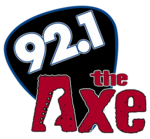  | |
| Broadcast area | Charleston, Illinois Mattoon, Illinois |
|---|---|
| Frequency | 92.1 MHz (HD Radio) |
| Branding | 92.1 the Axe |
| Programming | |
| Format | Classic rock |
| Subchannels | HD2: Sports "Victory 103.9" |
| Ownership | |
| Owner |
|
| WMCI, WCBH | |
| History | |
First air date | October 1, 1965 (as WEIC-FM)[1] |
Former call signs | WEIC-FM (1965[2]-1993)[3] WHQQ (1993–1997)[3] |
| Technical information[4] | |
Licensing authority | FCC |
| Facility ID | 72317 |
| Class | A |
| ERP | 6,000 watts |
| HAAT | 100 meters |
Transmitter coordinates | type:city 39°31′40″N 88°21′23″W / 39.52778°N 88.35639°W |
| Translator(s) | HD2: 103.9 W280EK (Mattoon) |
| Links | |
Public license information | |
| Webcast | Listen Live Listen Live (HD2) |
| Website | www www |
WWGO (92.1 FM) is a radio station broadcasting a Classic rock format. Licensed to Charleston, Illinois, the station is owned by Cromwell Radio Group, through licensee The Cromwell Group, Inc. of Illinois.[5]
History
[edit]The station began broadcasting October 1, 1965, and originally held the call sign WEIC-FM.[1][2] The station was originally owned by Friendly Broadcasters, Inc.[2] In 1967, the station was sold to Community Communications Associates, along with its AM sister station.[2][6]
The station originally simulcast the MOR format of its sister station WEIC 1270, but in December 1971, the station adopted a progressive rock format, while its sister station adopted a top 40 format.[7][1] By 1973, the station was simulcasting the top 40 programming of WEIC 1270 during the day, while airing country music from 6 p.m. to 10 p.m. and progressive rock 10 p.m. to 2 a.m.[8] In the following years, the station would return to simulcasting AM sister station most of the time.[9] The station was purchased by Withers Broadcasting in 1975.[2] In 1980, the station was sold to Macomb Broadcasting Co., along with its AM sister station, for $700,000.[10]
By 1984 the station was airing an adult contemporary format, separate from its AM sister station.[11] In 1984, the station was sold to Steve Garman, along with its AM sister station, for $628,000.[12] The station continued airing an adult contemporary format into the early 1990s.[13]
In 1993, the station's call sign was changed to WHQQ,[3] and the station adopted an oldies format, playing music from the late 1950s to the early 1970s.[14][15] The station was sold to The Cromwell Group later that same year.[16] In 1997, the station's call sign was changed to WWGO,[3] and the station's format was changed from oldies to dance/CHR, branded "The Party", with the WHQQ call sign and its oldies format moving to 98.9.[17] By 2002, the station was airing a rock format.[18]
References
[edit]- ^ a b c Broadcasting Yearbook 1971, Broadcasting, 1971. p. B-60. Retrieved July 11, 2018.
- ^ a b c d e History Cards for WWGO, fcc.gov. Retrieved July 11, 2018.
- ^ a b c d Call Sign History, fcc.gov. Retrieved July 13, 2018.
- ^ "Facility Technical Data for WWGO". Licensing and Management System. Federal Communications Commission.
- ^ WWGO fcc.gov. Accessed September 29, 2012
- ^ History Cards for WEIC, fcc.gov. Retrieved July 11, 2018.
- ^ "Charleston to Top 40 & Rock", Billboard, January 1, 1972. p. 10. Retrieved July 11, 2018.
- ^ Hall, Claude. "Vox Jox", Billboard, October 20, 1973. p. 34. Retrieved July 13, 2018.
- ^ Broadcasting Yearbook 1979, Broadcasting, 1979. p. C-63. Retrieved July 13, 2018.
- ^ "Changing Hands", Broadcasting, February 25, 1980. p. 77. Retrieved July 13, 2018.
- ^ Broadcasting/Cablecasting Yearbook 1984, Broadcasting/Cablecasting, 1984. p. B-76. Retrieved July 13, 2018.
- ^ "Changing Hands", Broadcasting, April 9, 1984. p. 94. Retrieved July 12, 2018.
- ^ The M-Street Radio Directory. 1992/1993. p. 137. Retrieved July 13, 2018.
- ^ "WEIC-FM Changes Format, Call Letters", Journal Gazette. May 5, 1993. p. A9.
- ^ The M-Street Radio Directory. 1994. p. 146. Retrieved July 13, 2018.
- ^ "Proposed Station Transfers", The M-Street Journal. Vol. 10 No. 29. July 21, 1993. p. 4. Retrieved July 14, 2018.
- ^ "Format Changes", The M-Street Journal. Vol. 14 No. 45. November 12, 1997. p. 1. Retrieved July 13, 2018.
- ^ Devine, Cathy (2002). The M-Street Radio Directory. 11th Edition 2002-2003. p. 185. Retrieved July 14, 2018.
External links
[edit]- Cromwell Radio Mattoon
- WWGO's website
- Facility details for Facility ID 72317 (WWGO) in the FCC Licensing and Management System
- WWGO in Nielsen Audio's FM station database
- Facility details for Facility ID 138373 (W280EK) in the FCC Licensing and Management System
- W280EK at FCCdata.org
Well, that’s interesting to know that Psilotum nudum are known as whisk ferns. Psilotum nudum is the commoner species of the two. While the P. flaccidum is a rare species and is found in the tropical islands. Both the species are usually epiphytic in habit and grow upon tree ferns. These species may also be terrestrial and grow in humus or in the crevices of the rocks.
View the detailed Guide of Psilotum nudum: Detailed Study Of Psilotum Nudum (Whisk Fern), Classification, Anatomy, Reproduction